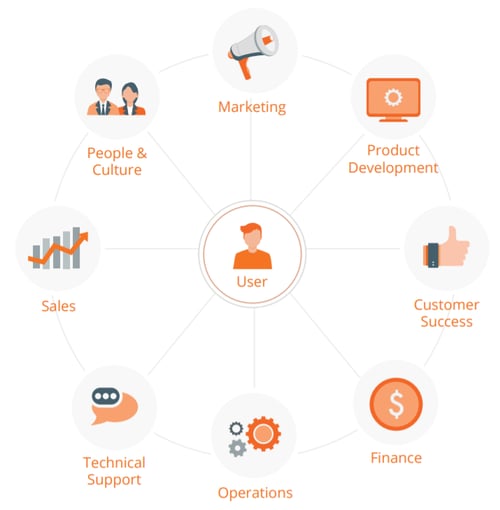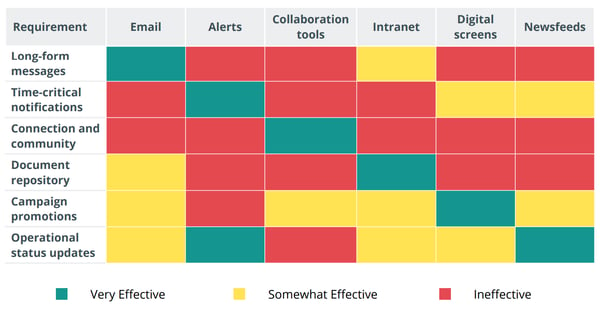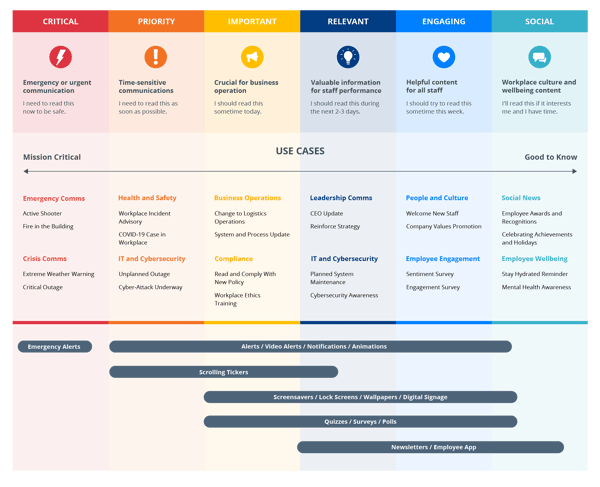
It’s a time of almost unprecedented change for businesses across the world. The hangover from COVID-19 and the challenges of increasingly competitive marketplaces are putting strains on leaders.
In times like this, businesses need every edge to keep operating and stay ahead of the pack. Employees are the greatest asset a business possesses – and internal communications is the key to unlock their power.
But businesses today face a major problem. We’re communicating more – but staff are listening less. Why is that?
In our haste to get messages out to staff, we’re neglecting the right way to deliver them. We’re guilty of ‘sent and forget’ syndrome. Sending messages in ways unsuited to the content, and the results are often dismal, if the results are measured at all. Low awareness, declining readership, flatlined engagement.
But there is a solution. A strategic framework that maximizes communications effectiveness and business performance. We call it the Communications Spectrum. Here’s why your business needs this tool – and how you can get it.
Communication Breakdown
As a business leader, you rely on employee communications to motivate staff, direct efforts and sustain growth. But our misuse of communications is putting workplaces at risk.
Different functional areas of your business are inundating staff with high volumes of low relevance messages. Corporate comms are notifying staff of organizational changes. IT are alerting to a cyber security threat. Compliance & Ethics are issuing an updated company policy. HR are unveiling a health and safety initiative. Operations are advising of shift changes… and the list goes on.

In addition, every function is resorting to the same ungoverned, unsuited and overused communication channels. Email inboxes expand by the minute with unread emails. Collaboration tools constantly flash with unimportant chat messages.
Every message has conflicting demands and is competing for employee attention. The result? Information-overload and message-fatigue. But the full impact is much more serious.
Assessing The Impact
In environments like this, employee engagement and productivity is diminished. But this also impacts the entire business, disrupting focus on achieving key business objectives.
Every employee loses 8 hours per week in unproductive time due to information-overload. Every missed message is a missed opportunity for the business to drive action, grow knowledge, improve performance or lift employee engagement.

For business leaders, this has a direct line to business performance in reduced efficiency, wasted effort and lower ROI. Approximately $15,000 per employee, per year is wasted due to inefficient communications.
Employees are unequipped with information essential to performing their role to the highest standards. This leads to lower levels of customer satisfaction, breaches of process and reduced quality of output. Workplaces with disengaged staff have twice as many safety incidents and 4x more quality defects.
It’s clear that our employee communications have gotten off course. A rethink of our approach is required.
Course Correction – Getting Back On Track
Internal business communications fail when single tools are used for diverse communications objectives. Flooding a single channel like email with multiple messages on different subjects, each with a different intent, dilutes the effectiveness of the channel and the impact of the communication.
Relying on email is a dangerous tactic. More than three-quarters of staff don’t click through from internal emails. Important information is being missed.
Channel selection is fundamental to effective business communication. Every communication tool has inherent strengths and weaknesses. Successful use requires evaluating the attributes of each channel against the communications objectives and how this ultimately impacts business goals.

The solution is two-fold:
- Spreading your employee communications across a diverse range of tools, where goals are matched with dedicated channels to achieve the right outcomes.
- Delivering content in a consistent style and manner that conditions employees to pay attention and respond.
But despite this, fewer than half of all internal communicators use a formal framework to direct their activities. That’s why the results are generally disappointing – and why a new approach to employee communication strategy is needed.
The Communications Spectrum
The Communications Spectrum is a business communications solution for achieving your goals through maximizing communications effectiveness.
It does this by defining the critical pathways linking objectives, channels, messages and results. Combining best practice in communications, psychology and management, it’s a framework that integrates fully into your wider communication plan.
The tiered format of the Communications Spectrum reflects the steps involved in business decision-making and communication. Business objectives are defined (top layer), which are translated into communication needs (middle layer), before being communicated to staff (bottom layer), who then respond accordingly.
Using the Communications Spectrum is appealingly simple but profoundly effective.
- Find where your objective sits on the top layer – how critical is it? This ranges from high criticality on the left to non-critical (or social) on the right. Each communication objective includes a definition of its relevance to the business and the desired employee response.
- Identify your communications need in the middle layer. This is what links objectives with channels through use cases – specific communication needs common to different functional areas.
- Select the optimal communication channels recommended in the bottom layer. More intrusive channels have high-impact formats that deliver immediate widespread attention. Less intrusive channels use subtle formats that achieve sustained behavioral change.
The Communications Spectrum works because it’s a practical tool every business can – and should – use. In aligning business goals with messaging outputs, it is a powerful driver for business success.
Our exclusive free guide contains everything you need to use the Communications Spectrum in your organization. Complete with workplace insights, critical analysis and a range of purpose-built templates, this guide is an essential business tool. Download your copy today.


